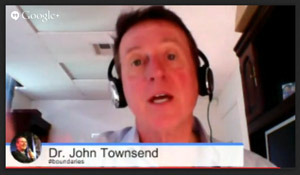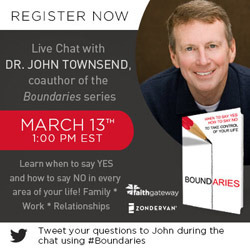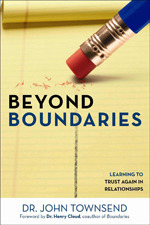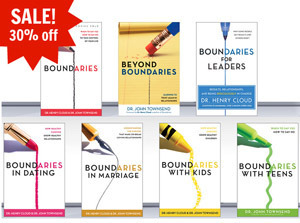Henry Cloud's Blog, page 34
March 14, 2014
Watch the John Townsend Video Replay and get a BIG Discount
 The author video chat with Dr. John Townsend yesterday, March 13th, was a huge success! Over 1,200 people registered, and Dr. Townsend took time to answer as many questions as possible.
The author video chat with Dr. John Townsend yesterday, March 13th, was a huge success! Over 1,200 people registered, and Dr. Townsend took time to answer as many questions as possible.
To watch the video replay for free, use this link.
Dr. Townsend covered a wide range of questions about boundaries topics, including:
Adult children setting boundaries with their mom
Setting boundaries with teenagers
Examples of how Jesus set boundaries with people
The 3 biggest hurdles to setting healthy boundaries
Dealing with people who are “boundary-busters”
Developing boundaries in marriage with a controlling spouse
Setting boundaries with employees and employers at work
Watch Dr. Townsend provide helpful answers to these big questions.
Even better, if you watch the replay, you will get access to a special discount code that saves up to 45% off on all Boundaries books and products. This limited-time discount is only good for 48 hours after the video chat. So, watch the video replay today, get great solutions from Dr. Townsend, and save money purchasing Boundaries books.
Learn from Dr. Townsend why boundaries really make life better!
The post Watch the John Townsend Video Replay and get a BIG Discount appeared first on Boundaries Books.
March 10, 2014
How to Risk Trusting Someone Again
 When you’ve been let down by someone who matters a great deal to you, moving beyond boundaries is not easy work — but it is important. One thing you can do in this regard is to figure out if the problem that was previously an obstacle is truly being transformed. In other words, is this person really changing? Is the big problem being solved the right way?
When you’ve been let down by someone who matters a great deal to you, moving beyond boundaries is not easy work — but it is important. One thing you can do in this regard is to figure out if the problem that was previously an obstacle is truly being transformed. In other words, is this person really changing? Is the big problem being solved the right way?
Here’s an example. I (Dr. Townsend) worked with a couple in which the husband, Bill, was a nice guy but irresponsible. He was one of those likeable people who loves to hang out with others and is a lot of fun. But Bill’s performance in life did not match up to his personality, especially in the area of finances and spending. He overspent on cars, gadgets, and entertainment. He also hid his spending habits, which meant his wife, Pam, was routinely surprised by huge credit card bills. These patterns took a major toll on the marriage. Pam was terrified of an uncertain financial future with him. She was not perfect and had her own issues as well, but his behavior came close to breaking up the marriage.
In our work together, Pam was clear that though she still loved Bill, she had lost all trust in him. She could not believe anything he said. “If he told me at noon that the sun was shining, I would go outside to check,” she said. As is common in these situations, Bill did not want to acknowledge the severity of the problem or make the necessary changes. He wanted Pam to change, to stop blaming him, and to learn to trust him. “If you would be nicer to me and trust me,” he said, “I would feel more supported, and I’d do better in my career.”
I had to step in there and say, “You are right; she shouldn’t be mean to you or attack you. But I don’t want her to trust you.”
Bill was bothered by that and said, “Don’t you want the marriage to work out?”
“Sure I do,” I said. “I want Pam to love you with no strings attached. But that is different from trust. While love is free, trust is earned. In the area of financial responsibility, I don’t want her to relax and trust you until we have evidence that you have changed.”
Again, Bill didn’t like that: “You’re both judging me,” he said.
“No,” I said, “neither of us is consigning you to hell. There is no judgment in this office. But you have not shown that you understand how deeply you have hurt her, nor have you made the necessary changes so that she can trust you again. If you and I were neighbors and I borrowed your screwdriver and didn’t return it, then borrowed your saw and didn’t return it, then your pliers and didn’t return them, what would you do if I asked to borrow your hammer?”
“Of course I wouldn’t lend it to you,” he said. “Okay, I see the point.”
Bill wasn’t as sorry as I wanted him to be at that point. He still didn’t seem to be able to acknowledge the impact he had on his wife, but it was progress.
“Here’s the deal,” I said. “I want you to submit your finances to Pam on a monthly basis for a year. She is in charge. You both see a financial planner together. And we’ll see, month by month, if you are really changing for her sake and the relationship’s sake.”
I turned to Pam: “If he does what I am asking, would you be open to trusting him again?”
“I would,” she replied. “I want to get all this behind us. But it has to be real.”
They agreed to the plan. Bill did some blaming at first, which happens frequently. But he humbled himself and allowed her to be in charge of the money. As it turned out, Bill did fine. And Pam was able to get past her hurt and mistrust, because he had truly changed.
Hurt and mistrust are nothing more than signals. They tell you that you either have some healing to do, or the other person has some changing to do—or both. So, while monitoring if you are learning to trust again, also monitor how the other person is doing in the arena that caused a break in trust in the first place.
Beyond Boundaries shows you how to move past relational pain to experience the freedom and love God designed for your most important relationships. Click here to read a sample chapter, watch a free video, and purchase your copy.
“Trust” image courtesy of Stuart Miles at FreeDigitalPhotos.net
The post How to Risk Trusting Someone Again appeared first on Boundaries Books.
March 6, 2014
Dr. John Townsend Answers Your Boundaries Questions on March 13th
 What if you could ask your most pressing questions about setting healthy boundaries to the world’s foremost expert? Here’s your chance! Dr. John Townsend, co-author of Boundaries, will respond to your boundaries questions in an exclusive, live, video chat!
What if you could ask your most pressing questions about setting healthy boundaries to the world’s foremost expert? Here’s your chance! Dr. John Townsend, co-author of Boundaries, will respond to your boundaries questions in an exclusive, live, video chat!
When: Thursday, March 13th at
1:00pm EST / 10:00am PST
This event is FREE, but you must register online to reserve your spot. By registering, you’ll also receive special discounts on Boundaries products (see details below).
Join Dr. John Townsend and get your questions answered about when to say yes and how to say no. For example, do you wrestle with any of these confusing situations?
How do I set limits and still be a loving person?
What if someone is upset or hurt by my boundaries?
What does a legitimate boundary look like?
Why do I feel guilty or afraid when I consider telling someone “no”?
What can I do when someone wants more of my time, love, energy, or money than I’m comfortable giving?
Dr. Townsend will answer as many questions as time allows. Tweet your questions before or during the chat to @FaithGateway using hashtag #Boundaries.
Don’t miss this FREE event! Register now!
Not Able to Attend?
You can still register, and we’ll send you the video replay link the next day!
Get a Great Deal on Boundaries Products
The entire Boundaries collection is on sale at the FaithGateway Store. Plus, when you watch the video chat, you will receive a special discount for even more savings! Register now for the video chat with Dr. Townsend.
Click here to purchase Boundaries products.
The post Dr. John Townsend Answers Your Boundaries Questions on March 13th appeared first on Boundaries Books.
March 3, 2014
Boundaries, Compliance, and the Fear of Saying No
 “May I tell you something embarrassing?” Robert asked me (Dr. Townsend). A new client, Robert was trying to understand why he had so much difficulty refusing his wife’s constant demands. He was going broke trying to keep up with the Joneses.
“May I tell you something embarrassing?” Robert asked me (Dr. Townsend). A new client, Robert was trying to understand why he had so much difficulty refusing his wife’s constant demands. He was going broke trying to keep up with the Joneses.
“I was the only boy in my family, the youngest of four children. There was a strange double standard in my house involving physical fighting.” Robert cleared his throat, struggling to continue. “My sisters were three to seven years older than me. Until I was in sixth grade, they were a lot bigger and stronger. They’d take advantage of their size and strength and wale on me until I was bruised. I mean, they really hurt me.
“The strangest part of it all was my parents’ attitude. They’d tell us, ‘Robert is the boy. Boys don’t hit girls. It’s bad manners.’ Bad manners! I was getting triple-teamed, and fighting back was bad manners?” Robert stopped. His shame kept him from continuing, but he’d said enough. He had unearthed part of the reason for his conflicts with his wife.
When parents teach children that setting boundaries or saying no is bad, they are teaching them that others can do with them as they wish. They are sending their children defenseless into a world that contains much evil. Evil in the form of controlling, manipulative, and exploitative people. Evil in the form of temptations.
To feel safe in such an evil world, children need to have the power to say things like:
“No.”
“I disagree.”
“I will not.”
“I choose not to.”
“Stop that.”
“It hurts.”
“It’s wrong.”
“That’s bad.”
“I don’t like it when you touch me there.”
Blocking a child’s ability to say no handicaps that child for life. Adults with handicaps like Robert’s have this first boundary injury: they say yes to bad things.
This type of boundary conflict is called compliance. Compliant people have fuzzy and indistinct boundaries; they “melt” into the demands and needs of other people. They can’t stand alone, distinct from people who want something from them. Compliants, for example, pretend to like the same restaurants and movies their friends do “just to get along.” They minimize their differences with others so as not to rock the boat. Compliants are chameleons. After a while it’s hard to distinguish them from their environment.
The inability to say no to the bad is pervasive. Not only does it keep us from refusing evil in our lives, it often keeps us from recognizing evil. Many compliant people realize too late that they’re in a dangerous or abusive relationship. Their spiritual and emotional “radar” is broken; they have no ability to guard their hearts (see Proverbs 4:23).
This type of boundary problem paralyzes people’s “no” muscles. Whenever they need to protect themselves by saying no, the word catches in their throats. This happens for a number of different reasons:
Fear of hurting the other person’s feelings
Fear of abandonment and separateness
A wish to be totally dependent on another
Fear of someone else’s anger
Fear of punishment
Fear of being shamed
Fear of being seen as bad or selfish
Fear of being unspiritual
Fear of one’s overstrict, critical conscience
This last fear is actually experienced as guilt. People who have an overstrict, critical conscience will condemn themselves for things God himself doesn’t condemn them for. As Paul says, “Since their conscience is weak, it is defiled” (see 1 Corinthians 8:7). Afraid to confront their unbiblical and critical internal parent, they tighten appropriate boundaries.
When we give in to guilty feelings, we are complying with a harsh conscience. This fear of disobeying the harsh conscience translates into an inability to confront others—a saying yes to the bad—because it would cause more guilt.
Biblical compliance needs to be distinguished from this kind of compliance. Matthew 9:13 says that God desires “compassion, and not sacrifice.” In other words, God wants us to be compliant from the inside out (compassionate), not compliant on the outside and resentful on the inside (sacrificial). Compliants take on too many responsibilities and set too few boundaries, not by choice, but because they are afraid.
 Big News: What if you could get your personal questions about setting boundaries answered by the world’s foremost expert? Here’s your chance! Dr. John Townsend (co-author of Boundaries) will take your boundaries questions during a live, nationwide, video chat on Thursday, March 13th. This event is free, but you must register here to reserve your spot.
Big News: What if you could get your personal questions about setting boundaries answered by the world’s foremost expert? Here’s your chance! Dr. John Townsend (co-author of Boundaries) will take your boundaries questions during a live, nationwide, video chat on Thursday, March 13th. This event is free, but you must register here to reserve your spot.
 If compliance has taken control over your life, find freedom by reading Boundaries. In addition, learn how to set boundaries in a supportive group setting with the Boundaries DVD Small Group Study.
If compliance has taken control over your life, find freedom by reading Boundaries. In addition, learn how to set boundaries in a supportive group setting with the Boundaries DVD Small Group Study.
Image courtesy of Stuart Miles at FreeDigitalPhotos.net
The post Boundaries, Compliance, and the Fear of Saying No appeared first on Boundaries Books.





